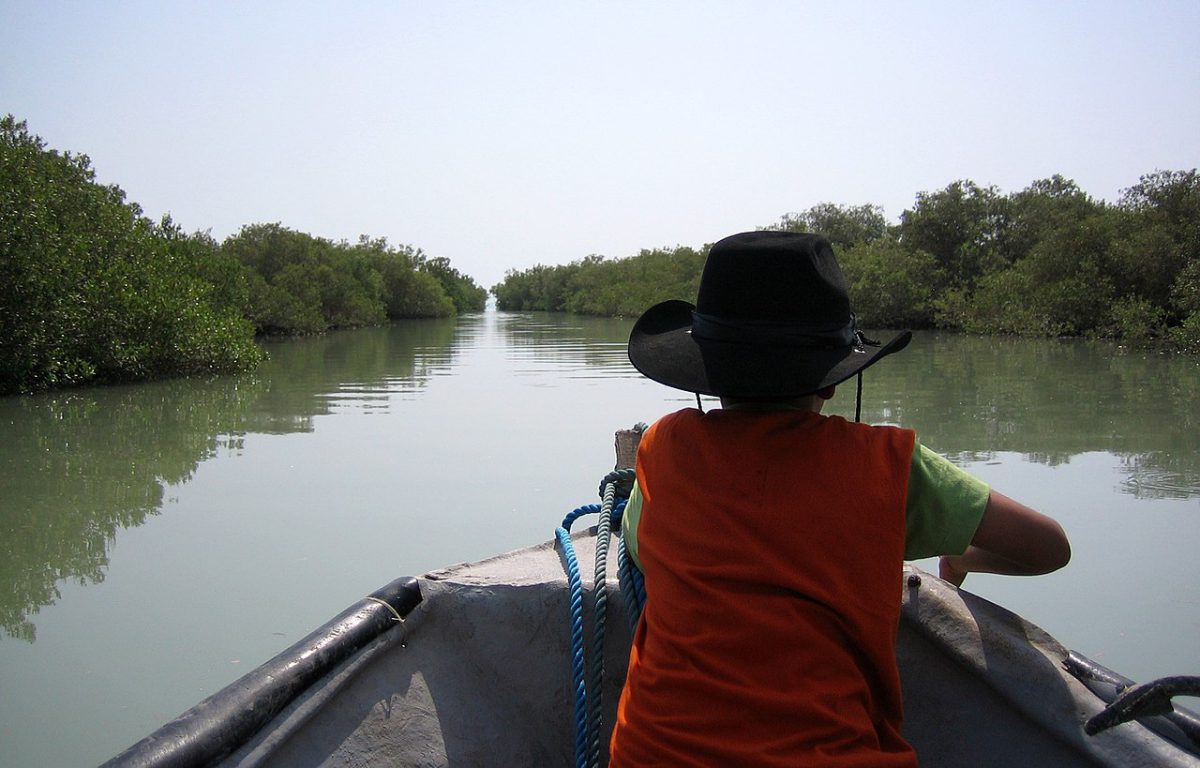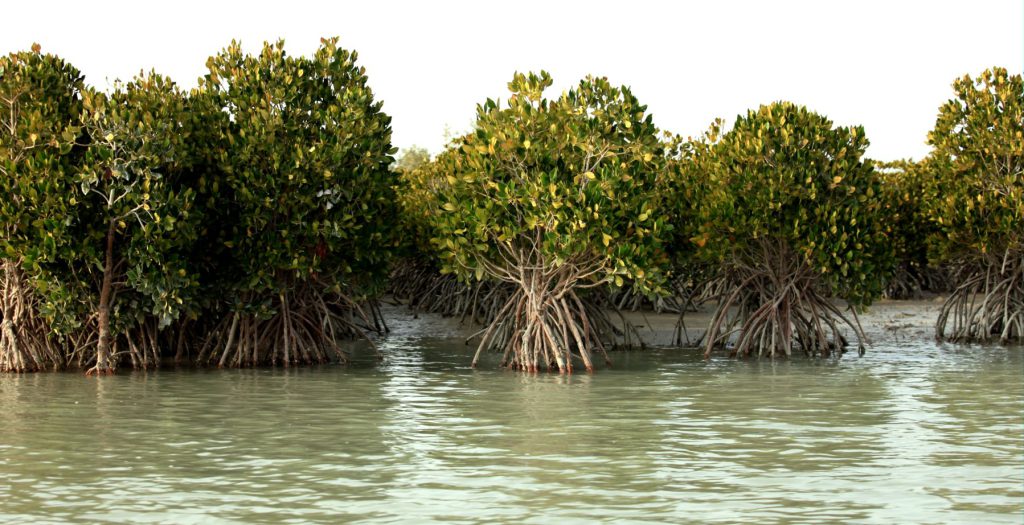Table of Contents
Located between Qeshm Island and the Hormozgan Province in the Strait of Khavaran, the Mangrove Forests, also known as the Hara forests, stand as a testament to nature’s wonder. These forests stretch beyond Qeshm, reaching the Port of Pohl, Hormuz Island, and Khamir Port. Covering approximately 2,400 hectares, Qeshm’s Hara Forest is the largest among Iran’s eight Hara forests. Recognized as a national protected area and an international lagoon, these forests are listed as UNESCO biosphere reserves, highlighting their global significance.
Locally referred to as “Hara” or “Harra,” the scientific name of this resilient mangrove species is Avicennia Marina, named after the renowned Iranian physician and biologist Avicenna (Abu Ali Sina). According to local lore, these miraculous trees sprang from the tears of Adam. The mystique surrounding these forests, coupled with their ecological importance, makes the Hara Forests a captivating subject for both nature enthusiasts and cultural historians.
Mangrove Forests of Qeshm Facts
Lifespan and Adaptation
The Mangrove forests of Qeshm boast an incredible lifespan of 30 to 40 million years. These ancient trees, submerged in the sea and emerging with the tides, create a mesmerizing and unique spectacle. Adapted to their brackish environment, they function like natural desalination plants, filtering out salt and thriving in freshwater. Forever lush and green, they present a stunning visual contrast against the blue sea, with their submerged trunks giving the illusion of floating foliage.
Natural Filtration System
The Hara Forest, also known as the mangrove forests of Qeshm, possesses a remarkable natural filtration system that allows it to thrive in saltwater environments. The trees in this forest, primarily the Avicennia marina species, have developed a unique adaptation through natural selection over millions of years. These mangrove trees act as living desalination plants, effectively filtering saltwater to obtain the freshwater they need for survival. Their specialized root system absorbs seawater but excludes most of the salt, allowing the trees to access the freshwater component. This adaptation enables the Hara Forest to flourish in brackish coastal areas without relying on external freshwater sources.
The process is a testament to the power of evolutionary adaptation. Over time, these trees have developed complex mechanisms to cope with high salinity levels, including salt-filtering roots and salt-excreting leaves. This natural filtration system not only ensures the trees’ survival but also contributes to the broader ecosystem by creating a unique habitat that supports a diverse range of marine and terrestrial life. The Hara Forest’s ability to thrive in these challenging conditions highlights the incredible resilience and adaptability of nature, showcasing how ecosystems can evolve to overcome environmental challenges.
A Birdwatcher’s Paradise
As the cold season arrives, the Hara forests transform into a haven for birdwatchers, attracting over 100 species of migratory birds, including cuckoos, egrets, and gray Salim. The receding tide reveals the intricate root system of the mangroves, allowing adventurous visitors to walk among the trees, though boots are a necessity for navigating the muddy terrain. To explore these enchanting forests, one can embark from the Tabal village wharf, Soheili wharf, or Bandar-e-Laft by boat, venturing into the heart of this verdant paradise as the sea level rises.
Mangrove Forests of Qeshm Animals
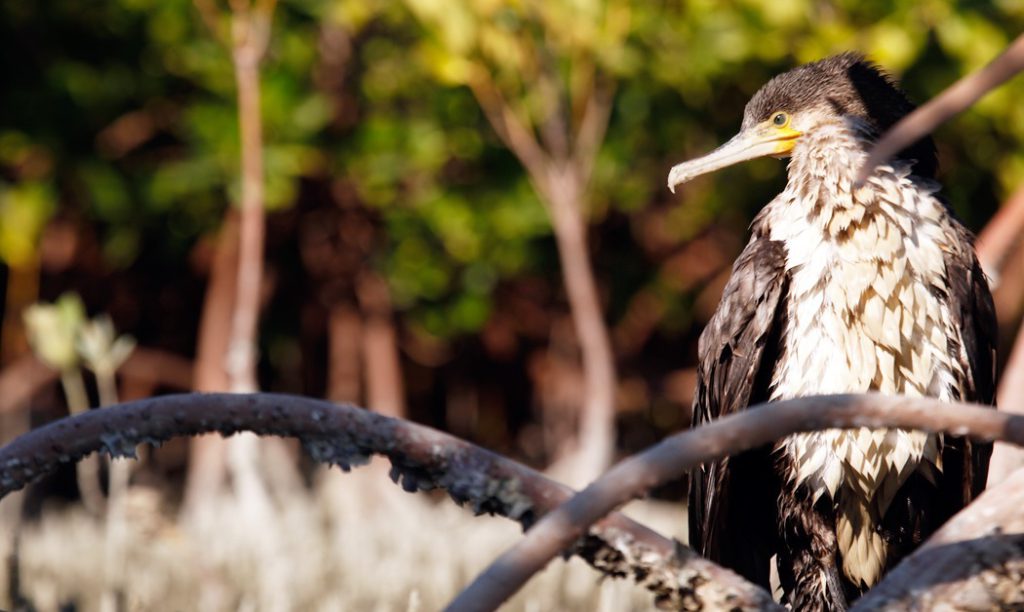
The mangrove forests of Qeshm are a vibrant ecosystem teeming with life, showcasing a remarkable diversity of animals. Among the most striking inhabitants are the elegant herons, graceful flamingos, and robust pelicans, all of which can be spotted wading through the shallow waters or soaring overhead. Herons, with their long legs and sharp beaks, are expert fishers, while flamingos add a splash of color as they filter-feed on brine shrimp and algae. Pelicans, known for their impressive wingspans and unique fishing techniques, often hunt in cooperative groups, demonstrating the intricate relationships that exist within this habitat.
In addition to these avian wonders, the mangroves host a variety of reptiles, fish, and invertebrates, creating a bustling underwater community. Eels glide through the murky waters, while various species of arthropods, including crabs and shrimp, scuttle along the muddy banks. Bivalves like oysters cling to the roots of the mangroves, filtering nutrients from the water. This rich tapestry of life not only supports the birds and reptiles but also plays a crucial role in maintaining the ecological balance of the region, making the mangrove forests of Qeshm a vital sanctuary for wildlife enthusiasts and researchers alike.
Things to Do in Mangrove Forests of Qeshm
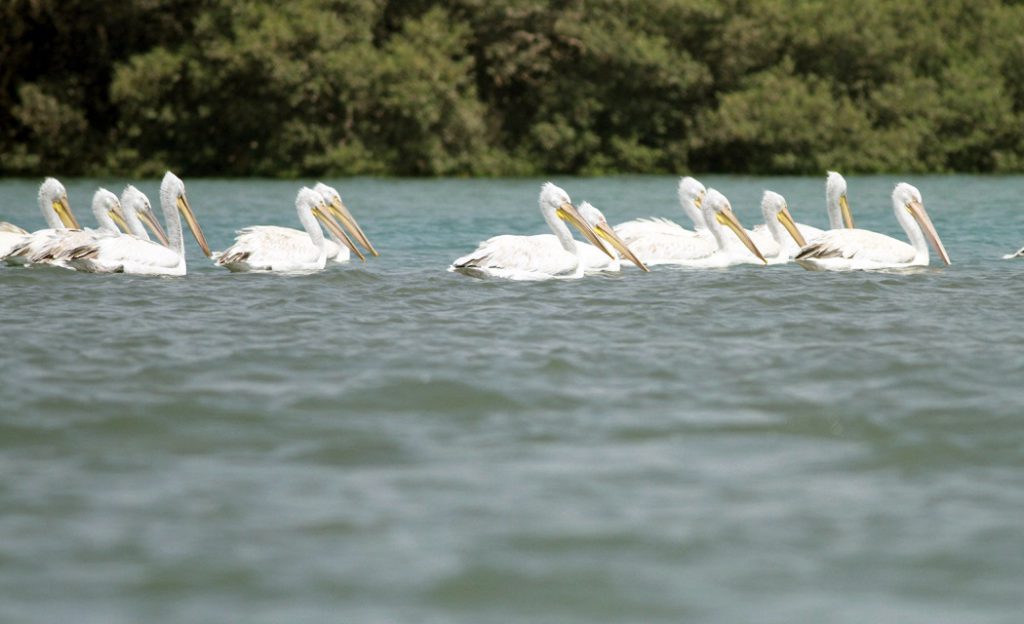
Boating
A boating tour is undoubtedly one of the most captivating ways to immerse yourself in the enchanting Hara Forest. As your boat glides across the turquoise-blue waters of the Persian Gulf, you’ll be treated to a mesmerizing transition from the ordinary to the extraordinary.
Initially, the journey may seem like a typical boat ride, but soon you’ll find yourself surrounded by a breathtaking landscape, where trees appear to float atop the water. If you’re lucky, you might even catch a glimpse of playful dolphins swimming amidst the lush greenery. Remember to observe the tranquility of the environment carefully, as this will allow you to capture truly memorable photographs of the region’s vibrant birdlife, nesting high in the treetops.
Birdwatching
For the avid birdwatcher seeking a truly immersive experience, the Qeshm mangrove forest stands out as one of the premier destinations. The best time to visit is during the months of December and February, when you can observe these colorful avian wonders in complete silence, allowing you to fully appreciate their natural beauty and grace.
Beyond simply birdwatching, the Qeshm mangrove forest also offers the opportunity to camp amidst the lush greenery, further enhancing the sense of tranquility and connection with nature.
Camel Riding
Imagine the surreal experience of riding a camel through the Qeshm mangrove forest, with the serene waters of the Persian Gulf lapping at the trees around you. This unique blend of desert and maritime environments creates a truly fantastical setting, one that will leave a lasting impression on your memory and your sense of adventure.
Tomb of Shah Shahid Avazhkhan
As you make your way to the Qeshm mangrove forest, you’ll be greeted by the captivating sight of the tomb of Shah Shahid, located just 11 kilometers from the city of Qeshm. Perched atop a hill and facing the sea, this awe-inspiring structure is said to have belonged to a man with a remarkable countenance and a skilled musician who was revered by the local people. The tomb’s stunning architecture and breathtaking coastal setting make it a must-visit destination on your journey through the Qeshm region.
How to Get to Mangrove Forests of Qeshm
To embark on an adventure to the enchanting mangrove forests of Qeshm, your journey begins at one of the key docks: Tabal village wharf, Soheili wharf, or Bandar-e-Laft. These points serve as gateways to the lush greenery that thrives in the brackish waters of the Persian Gulf. Once you arrive at any of these wharfs, the only way to explore the forest is by boat, which adds an exhilarating element to your visit.
As you navigate through the waterways, you’ll find yourself surrounded by the unique beauty of the mangrove ecosystem, where trees appear to float on the water’s surface.
Tips to Know
Accessing the captivating Qeshm mangrove forest is only possible by boat, which in itself is an exhilarating experience. To truly make the most of your journey, it’s highly recommended to enlist the services of a local guide, who can navigate you through the stunning and secure waterways, ensuring you witness the forest’s full splendor.
Best Time to Visit Mangrove Forests of Qeshm
The lush mangrove forests of Qeshm Island come alive with an enchanting vibrancy during the temperate months between October and May. This optimal visiting window allows nature enthusiasts to bask in the island’s refreshing ambiance, free from the scorching summer heat. As the temperatures gently caress the vibrant greenery, the mangrove canopies unfurl their mysteries, beckoning visitors to immerse themselves in this natural sanctuary.
Other Attractions in Qeshm Island
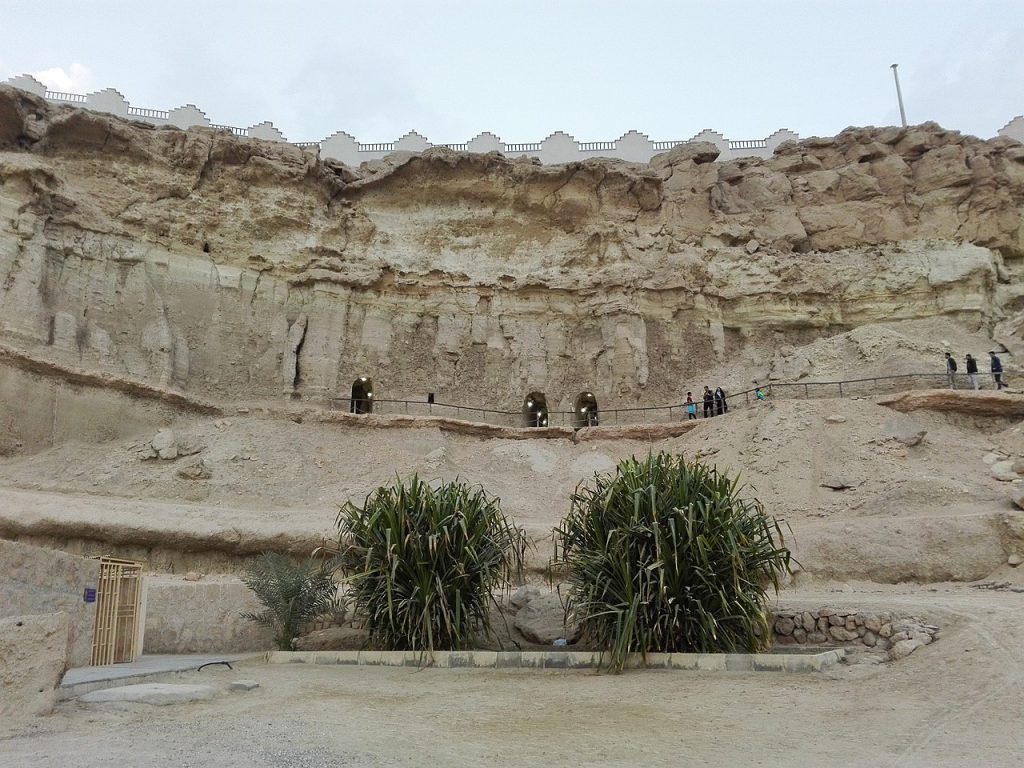
Khorbas Cave
Nestled among the coral hills, the Khorbas Cave is a true geological marvel, dating back to the 6th century BC and nestled within the folds of the Zagros Mountain Range. This ancient site is believed to have once served as a temple dedicated to Anahita, the Goddess of fertility, health, and wisdom, although its exact history remains shrouded in mystery.
As visitors explore the cave’s four entrances, they are greeted by the sight of ancient carvings and holes in the walls that act as natural windows, offering breathtaking views of the island’s south coast. But the true wonders lie within the cave itself, where the presence of ancient shells serves as a reminder of its underwater past. By delving into the history and tales of this captivating site, travelers can uncover Qeshm Island’s rich and enigmatic past.
Naz Islands
Just a kilometer away from the shores of Qeshm Island lies a captivating destination – the Naz Islands. These rocky wonders are linked to the main island by a path that emerges during low tide, inviting visitors on a unique journey across the shallows. As the sea level drops, travelers can embark on this fun and thrilling trek, adding an exhilarating twist to their exploration of Qeshm’s attractions.
But the adventure doesn’t end there. Naz Island offers a wealth of activities to delight every visitor – from horseback and camel rides to scenic photography and even fishing. With its natural beauty and exciting experiences, the Naz Islands have become a must-visit destination for anyone seeking to discover the wonders of Qeshm.
Hengam Island
Hengam Island, a true gem of the Qeshm region, captivates visitors with its breathtaking natural beauty. Its pristine beaches, adorned with clear, refreshing waters, offer the perfect setting for a wide array of water activities, making it a premier destination for those seeking sun and surf.
Yet, Hengam Island is more than just a sun-drenched paradise – it is a window into the vibrant culture of southern Iran. Here, the local inhabitants cherish their traditions, providing travelers with a unique opportunity to immerse themselves in the region’s rich heritage. Beyond its coastal charms, the island is also home to a diverse array of fascinating wildlife, including dolphins, crabs, and a special breed of gazelle. For anyone exploring the wonders of the Persian Gulf, a visit to Hengam Island promises an unforgettable adventure, blending stunning scenery, cultural richness, and remarkable biodiversity.
FAQs about Mangrove Forests of Qeshm
Q1: Where are the Mangrove Forests of Qeshm located?
A1: The Mangrove Forests of Qeshm are located between Qeshm Island and the Hormuzgan Province in the Strait of Khavaran, extending to the Port of Pohl, Hormuz Island, and Khamir Port.
Q2: What makes the Hara Forests significant?
A2: The Hara Forests are significant as they are a national protected area, an international lagoon, and are listed as UNESCO biosphere reserves, highlighting their global importance.
Q3: What 2 countries have the largest mangrove forest?
A3: Indonesia and Brazil have the largest mangrove forests.
Q4: Where are mangrove forests found?
A4: Mangrove forests are coastal woodlands that grow in salty water. They are found in tropical and subtropical areas near the equator, between 25° North and South latitude.
Q5: Where are mangrove forests areas?
A5: Mangrove forests are saltwater woodlands that grow in tropical and subtropical coastal areas and tidal estuaries.
Last Words: Explore the Best of the Mangrove Forests of Qeshm with a Customized Tour
The mangrove forests on Qeshm Island and in the surrounding Hormuzgan Province are known as the Hara Forests. These forests are located in the Strait of Khavaran and cover around 2,400 hectares, making Qeshm’s Hara Forest the largest of Iran’s eight Hara Forests. The Hara Forests are recognized as a national protected area and an international lagoon and are listed as UNESCO biosphere reserves due to their global importance.
For those seeking to immerse themselves in the captivating world of Qeshm’s mangrove forests, a customized tour is the ultimate way to maximize your experience. Enter To Iran Tour, a trusted provider of Iran tours and travel packages that specializes in crafting bespoke itineraries catered to your interests and preferences. Our team of knowledgeable local guides and travel enthusiasts are dedicated to designing the perfect Iran Tours that allow you to explore the Hara Forests in depth, uncovering the ecological wonders and cultural significance at your own pace.
Whether you’re drawn to the mystical legends surrounding the mangrove trees or simply seeking to marvel at the lush, vibrant landscapes, the experts at To Iran Tour are here to help you craft an unforgettable adventure.

